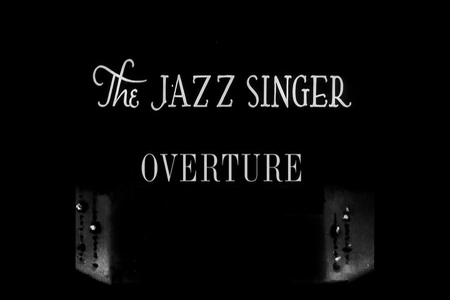
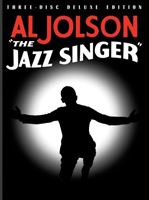 BUY FROM AMAZON: CLICK HERE!
BUY FROM AMAZON: CLICK HERE!
STUDIO: Warner Home Video
MSRP: $39.92
RATED: NR
RUNNING TIME: 89 min
SPECIAL FEATURES:
- Commentary by Ron Hutchison and Vince Giordano
- Vintage Al Jolson Shorts
- Radio Show Adaptation
- Movie Trailer Gallery
- Classic Homage Cartoon I Love to Singa
- The Dawn of Sound: How Movies Learned to Talk documentary
- Sound Excerpts from 1929’s Gold Diggers of Broadway
- Studio Shorts from or celebrating the early sound era
- Over 3 ½ hours worth of rare, historic Vitaphone shorts
The Pitch
You ain’t heard nothin’ yet.
The Humans
Al Jolson
The Nutshell
There was a time where there was no sound in films and everything was silent. Then a movie came along that changed everything.
The Lowdown
Before 1927 there had been some tinkering and experimentation done with synchronous sound in movies, yet it was not until 1927 and the release of The Jazz Singer that the world sat up and took notice. Warner Brothers was able to take the new technologies and break the walls down with a movie that would not work without the use of sound – the musical. To be honest, even I was unaware that this was still prominently a silent film. Only the musical numbers and small snippets of dialogue received the sound treatment. Sound technology was still hard to use and even in the films of this time using synched sound, it was difficult to pull off due to the large stationary cameras and the inability of actors to move too far away from the mics. Despite this, The Jazz Singer remains one of the pioneer movies in cinema history and has received a great package in this anniversary edition.
Disc One
The first disc in this package includes the actual movie, The Jazz Singer. The Jazz Singer tells the story of Jakie, whose father Cantor Rabinowitz refuses to accept the fact that his son does not want to follow in his footsteps as a Cantor for their church. When his father demanded that he do as he was told Jakie ran away from home. After running away, Jakie was discovered and became a famed jazz singer. When his father fell ill, and lay in his death bed, Jakie is forced to make a decision to either continue on to finally achieve his dream or return home to give his father his dying request and sing for the church.
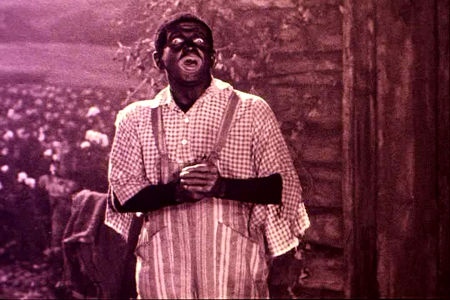
The acting was very solid. Al Jolson was a pretty big star at the time of the movie, and he pulled his weight admirably. He was not just a good voice but he turned out to be a quality actor who was able to carry the movie on his shoulders. It is clear he was much more comfortable when performing on stage, but he was still solid in his acting scenes as well. May McAvoy was quite good in the role as his girlfriend, Mary Dale, and both Warner Oland and Eugenie Besserer were spectacular as his parents.
What is most interesting about the story is that it is a love story in which the only true love being sought is between a mother and her son. There is a point where Mary and Jakie state that their careers are more important than their feelings towards each other. The movie seems from the start to be about Jakie trying to win the love of Mary, but it moves into a desire to only achieve his goal to be a jazz singer and nothing more. However the emotional importance of the story is the boy separated from his mother and his mother’s desire to see both her son and husband happy. It is through this area of the script that the movie succeeds.
The film really holds up well today. The story of a child who runs away and is determined to reach his dreams despite all that stands in the way has been done so many times over the years that it is almost cliché. However, for the time period, the story works well. The pacing is great and it is a movie that really keeps you interested up to the climax. I am sure there are detractors who point out their problems with the blackface scenes as well as the stereotyping in the film, but the movie is a product of its time and should be viewed as such. The Jazz Singer is one of the great silent films in cinema history and is a solid beginning to the sound era that was being ushered into Hollywood.
The next two accompanying shorts on the first disc are more a display of the advent of sound than any kind of structured story. In A Plantation Act, Jolson pretty much just stands in front of an old house and performs songs. An Intimate Dinner in Celebration of Warner Bros. Silver Jubilee is a horrible short that is just an example of the use of sound as “Mr. and Mrs. Warner Bros.” introduced their daughter “Vitaphone” who introduces all the major players on contract with Warner Bros. It was just a way to advertise the current and future films the studio was producing at the time.
I Love to Singa is the famous Warner Bros. cartoon that parodies The Jazz Singer.
Hollywood Handicap is a 1938 short film directed by Buster Keaton. It stars The Original Sing Band as a group of men whose boss gives them a horse. One member of the group comes up with one “powerful idea” after another that continues to get the boys deeper and deeper into trouble. Luckily everything turns out right in the end. The film is notable for the group’s acapella singing as well as the appearance of a number of high profile movie stars such as Bing Crosby, Al Jolson and Mickey Rooney. The short is quite entertaining and very much in synch with what you would expect from a Buster Keaton picture.
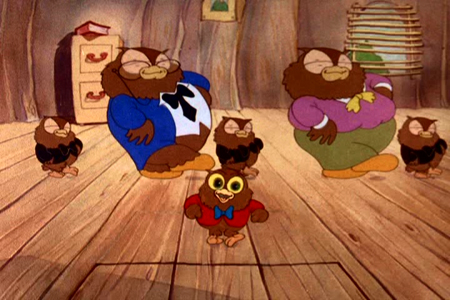
A Day at Santa Anita is a Technicolor short is an overly sentimental piece about a little girl whose dad dies and she is left alone with her only companion being a horse who will only respond to her. The acting is horrible in this picture, with the little girl incredibly annoying and the story was just bad. It is probably the weakest addition on this first disc. The only real point of interest comes when some big name stars show up and actually deliver lines, including Al Jolson and Ruby Keeler, Edward G. Robinson and Bette Davis.
Disc Two
The feature presentation on the second disc is a feature-length documentary called The Dawn of Sound: How Movies Learned to Talk. The documentary begins with the Warner brothers starting their movie empire and then moves on to Thomas Edison starting to work with synchronized sound in 1913 and D.W. Griffith experimenting with sound early on with Dream Street. Western Electric developed a sound technology but was turned down by all the studios because they were comfortable with silent films. Sam Warner was intrigued by the new technology and went into partnership with Western Electric to make sound pictures.
Don Juan was discussed as the true pioneer of sound in film, but it was the short films that accompanied it that really solidified the medium to the Warner brothers. The documentary is full of clips from all these samples of the short films that began the Vitaphone revolution. William Fox of Fox Studios came into the picture and began to work on production of sound films and the creation of scores for existing pictures. It still took the Vitaphone shorts for people to be convinced that a talkie could be a success thus leading to the decision to make The Jazz Singer.
The documentary is a fascinating look at the innovations that led to the advent of sound. The fact that so many people were reluctant to make the switch was interesting and the people who fought for the addition of sound are seen as rebels that led the way of the revolution. Sam Warner, the brother who led the fight for sound, would die before The Jazz Singer would ever be released making the story almost a tragic tale as the man who was most responsible would never see the final results of his hard work. This documentary, clocking in at just under an hour and a half, is close to a perfect look at one of the most important developments in film history.

The first short included on the second disc is The Voice from the Screen (1926). It is a presentation before the New York Electrical Society that explains the technology used to create sound on film. The second is Finding His Voice (1929), an animated cartoon synchronized to voice and sound. This is another educational short where “Mutie”, representing the silent film era, is taken by “Talkie” to Dr. Western to help him find his voice. He is led through the process of making a silent film into a talkie. The Voice that Thrilled the World (1943) is another educational short that shows the path to creating the sound used in films such as Yankee Doodle Dandy, with video of Thomas Edison and other scientists as they work on the process. Okay for Sound (1946) was originally released on the 20th anniversary of the first talkie and once again goes into detail on the advent of sound, this time comparing the talkies from the early days of the 1920s to the current ones of the 1940s. When the Talkies Were Young (1955) rounds out the shorts on this disc and is a more focused documentary as it goes into detail four early pictures and their stars. The films were James Cagney’s Sinner’s Holiday, Spencer Tracey and Bette Davis in 20,000 Years in Sing Sing, Edward G. Robinson’s Five Star Final and Barbara Stanwyck’s Night Nurse.
This disc is all history documentaries of the silent era and it is a very interesting look at the how these films tell the story through the passage of time.
Disc Three
Disc three contains over three hours of short films. You can either select Play All or play them one by one. Some of the films are not complete, as some pictures were lost due to nitrate decomposition, but the sound remains. The films in question attempts to deal with these losses by using freeze frames through the sections with the corrupt video while the sound continues to play.
Behind the Lines (1927) is a vaudeville act by musician Elsie Janus. The Wizard of the Mandolin (1927) stars Bernado De Pace who stands in front of a set and plays a mandolin while an orchestra plays as well. The Pennant Winning Battery of Songland (1929) is Gus Van and Joe Schenck doing one of their famous musical comedy routines. Blossom Seeley and Bennie Fields with the Music Boxes (1929) is another vaudeville act where the two perform three numbers while two men play pianos (music boxes) behind them. Hazel Green & Company (1927) presents Hazel Green singing while a band plays behind her.
The Night Court (1927) is the first actual narrative short on this disc. However, it is still a vaudeville act. It starts as a silent film with a title card and then uses sound when the actors are performing. A police raid on a nightclub revue brings the entire revue up for trial and the attorney requests that the performers be allowed to perform their acts for the judge. Each one is informed of the charges against them and then performs their acts for the judge. It is a vaudeville comedy that moves at a nice pace and is pretty funny with a cute punch line.
The Police Quartette (1927) includes a group of the same name performing four musical numbers. When East Meets West (1928) presents Ray Mayer and Edith Evans performing songs, with Mayer playing piano and both singing. Stories in Song (1928) presents Adele Rowland in another musical short. The Jazzmania Quintette (1928) is a musical performance by Stoll, Flynn & Company. The Band Beautiful (1928) are performances by an all female orchestra called The Ingenues. Chips off the Old Block (1928) is another vaudeville act, this one by the Foy Family including singing, dancing and comedy. Dick Rich and his Melodious Monarchs (1928) includes musical numbers by the group and a poorly done ventriloquism act with Rich’s wife playing the dummy. Gus Arnheim and his Ambassadors (1928) involves Arnheim leading his 15-piece orchestra in three numbers.

The Beau Brummels (1928) involves vaudeville performers Al Shaw and Sam Lee who perform comedy songs with a batch of jokes and quips in between. This was quite a funny short as the two men rarely smiled and their downtrodden appearances seemed a contrast to the comedy and worked very well. This might be the best short of them all so far. The two seem to have that perfect timing you would expect from the comedy pairings of the day. If you like dry and silly humor you will like this vaudeville act. These guys have it, whatever “it” is.
Roof Garden Review (1929) is a musical directed by Larry Ceballos, who went on to work on the lost classic Gold Diggers of Broadway. My Bag o’ Tricks (1929) is another vaudeville act, this time with Trixie Friganza, who performs some comedy skits. It is also one of the better vaudeville acts, as Friganza has quite good comic timing and is also very creative. Green’s Twentieth Century Faydetts (1929) is another orchestra musical performance. The Eccentric Entertainer (1929) is a musical performance by Sol Violinsky, who plays the piano and finishes his performance in impressive fashion as he plays the piano with one hand while simultaneously playing the violin with the other. It was quite unique to say the least.
At the Seashore (1929) is another short with a comedy team, this time Ethel Sinclair and Margaret La Marr. The two women sit at the beach and make quips and comments about anyone and everything they happen to see. La Marr makes most the observations while Sinclair makes most the quips and dishes out the harshest insults.
Paul Tremaine and his Aristocrats (1929) is a musical performance by a jazz band. Baby Rose Marie: The Child Wonder (1929) was a singing performance by six year old Rose Marie. Marie would grow up to be a successful actress, staring on The Dick Van Dyke Show, and even appearing in a movie as late 2004. Here, she is just a cute kid singing a batch of songs. Lambchops (1929) is a classic comedy short by the comedy team of George Burns and Gracie Allen.
Finally, The Happy Hottentots (1930) is an actual short film. It stars comedians Joe Frisco and Bob Callahan as two friends who wants to break into show business. They soon realize that the world they have stepped into is a living hell. The film is based on a true story that happened to a comedy team named Duff and Sweeney. The short is really quirky and the comedy is very funny. This is a great short to end the DVD with.
This DVD set is great if you are a fan of vaudeville acts but otherwise there is a lot of stuff here that might overwhelm you. Film students and fans of early black and white films will find a virtual treasure trove of gold here. Casual fans might not be as interested however. There is good stuff here, but be ready to clear a couple of days to sift through it all.
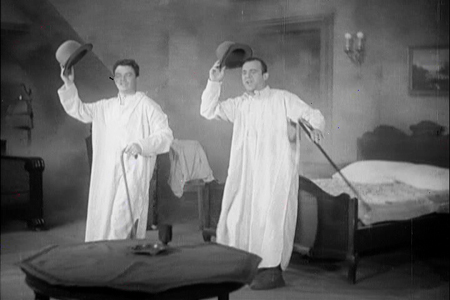
The Package
The look of this DVD is spectacular. It is crisp and clear and everything looks great. The sound, which is the most important experience when you consider the film, is great as well. A lot of work was done to make this look and sound as good as possible and they deserve credit for the final results. There are still small scratches and a little dirt, but it adds to the charm of the picture.
The first disc includes an audio commentary track by Ron Hutchison, founder of The Vitaphone Projects and Nighthawks Bandleader Vince Giordano during the feature presentation. The disc also includes the Lux Radio Theater Broadcast (6/2/1947) of Al Jolson’s The Jazz Singer. There is also an Al Jolson trailer gallery which includes The Jazz Singer, The Singing Fool, Mammy, Wonder Bar, Go Into Your Dance and The Singing Kid.
The second disc includes restored reels from the lost film Gold Diggers of Broadway. The film is the second talkie and was considered a lost film until the 1980s. It was almost completely forgotten despite the fact that it was the top grossing film of all time until 1939. There is still very little of the film to see, as it was considered completely lost until 1986 when the final reel was found. Ten years later a second reel was found, the Tip Toe through the Tulips production number. Both reels are included here. The final two minutes of video are missing from the production number, but the audio remains perfect. Together they clock in at 15:42.
The DVD’s come in a really nice set that includes many cool items. There is a replica of the souvenir program for The Jazz Singer. It comes with a warning that it contains many things that may depict racial and ethnic prejudices, but they wanted to present the program as it was originally created. It includes reviews, news articles and cast and crew listings. Then there is a Vitaphone brochure. There is a replica of the postcard that Al Jolson sent to Jack Warner following the death of his brother. There is also a replica of the ad for The Jazz Singer. Finally, there are ten studio stills and a booklet of script excerpts. All of this is housed in protective casings that slips into the DVDs box.
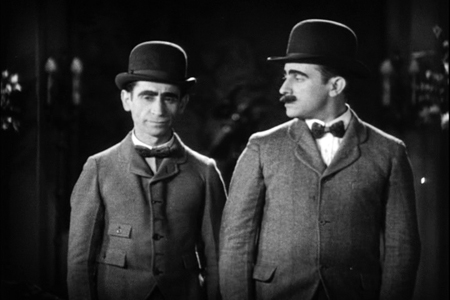
7.9 out of 10